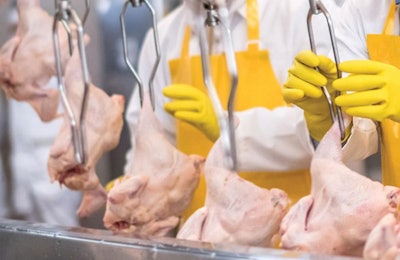
In many poultry processing plants there are procedures that may not be performed as efficiently as they could be. This can result in higher costs, lower output, or an increase in shift length. However, various solutions are available to address these issues ranging from simple adjustments to working with new technologies.
1. Confront delays at unloading
When broilers arrive at the processing plant they are unloaded, weighed and often moved to a waiting area prior to being hung on the shackles. This is a delay but, additionally, the process may not always run as smoothly as it could leading to further issues. Delays may mean that the working day will need to be extended and there may be additional costs if workers need to work later to process the birds delivered.
There are alternatives to this procedure. Some plants operate a system whereby, as soon as trucks arrive, the birds are automatically unloaded, weighed and then moved immediately to the hanging area. Once the first truck is emptied the process is repeated with the next truck.
In plants with a higher slaughter speed, multiple trucks may be parked and unloaded at the same time. A further advantage of immediately weighing birds and sending them straight to slaughter is that the final yield can be more accurately calculated than when a waiting period is implemented.
2. Reduce empty shackles
In many plants, it is common practice to leave a number of shackles empty between truckloads of chickens to help identify which birds came from which batches. The number of empty shackles is typically anywhere from 10 to 20, but this results in the plant running below capacity.
For example, a plant that processes 45,000 birds per day at a speed of 6,000 chickens per hour and leaves 10 shackles empty between truckloads.
The average time that it takes a shackle to make a full circuit of the plant is 10 minutes. Over an hour, it will complete the circuit six times. When multiplied by 10 that is 60 empty shackles.
If a shift lasts for seven-and-a-half hours there would be the equivalent of 450 empty shackles over the day. That equates to 11,250 per month, or 135,000 unused shackles annually.
Assuming that a truck carries 3,000 birds, that equals 45 trucks of lost production – or the equivalent of three days of processing. In this example, the efficiency of hanging is said to be 99%.
While the losses may seem huge, they can easily be reduced by leaving only five empty shackles - rather than the standard 10-20 - to demarcate between truckloads. This would cut the downtime for shackles in half. By reducing the number of empty shackles, the efficiency of hanging rises to 99.5% - this increase of only 0.5% is the equivalent of 22.5 truckloads of birds a year that can be slaughtered.
3. Control staff movements
Once processing workers have passed through hygiene controls, ensuring that they remain within their designated areas can be an issue in some plants.
Poultry processing plants have various levels of cleanliness, ranging from very dirty to extremely clean, and if workers from a dirty area enter a clean area then cross-contamination may occur.
In some plants this issue has been resolved by installing gates fitted with scanners and issuing staff bracelets. The bracelets must be scanned to open the gates which will only open for those with permission to enter the gated area.

Smart bracelets can play a variety of roles in increasing the performance of the processing plant, from preventing cross-contamination to monitoring worker efficiency. Anatolir | Bigstock.com
4. Address worker fatigue
Worker fatigue is another issue faced by plants on a daily basis. Ergonomically-designed equipment and workstations will reduce this, helping staff to achieve their maximum performance. In addition, staff are also often given 15 minute breaks during the work day, but taking a break at a set time may not work for all employees.
We all have differing levels of physical performance and because of this some workers will not be tired at the designated break times, but they become tired later in the day. To address this, some companies have issued employees with a fatigue-monitoring bracelet that alerts individual workers when they should take a break. To allow the shift to continue, an additional worker is temporarily brought onto the line to act as a replacement.
5. Monitor performance
In the cut up and deboning area, workers must deliver a predetermined yield within a set time. There needs to be tight control on both the whole birds arriving at the cut up area and also on the cut pieces leaving the area.
An intelligent bracelet may also be of value in this area and help to improve performance. In some fish processing plants, individual trays of fish activate a reader which can record how much time is taken for its contents to be cut up.
6. Improve operational efficiency
Poultry plants typically contain high levels of technology facilitating the processing of birds at high speeds and this means that any down time can be very costly.
Other industries may offer examples of how these stoppages can be minimized through the use of light and sound alarm systems which are used in other food processing plants. Strategically placed LED light columns, with four lights connected to a message system, could help to reduce downtime. A red light, for example, would indicate an emergency needing an immediate response; an amber light would indicate a warning; green would signify that everything was functioning normally; while a blue light would indicate that attention was needed.

Forewarned is forearmed, a simple warning system can advise staff as soon as an issue is detected. Hasenonkel | Bigstock.com















